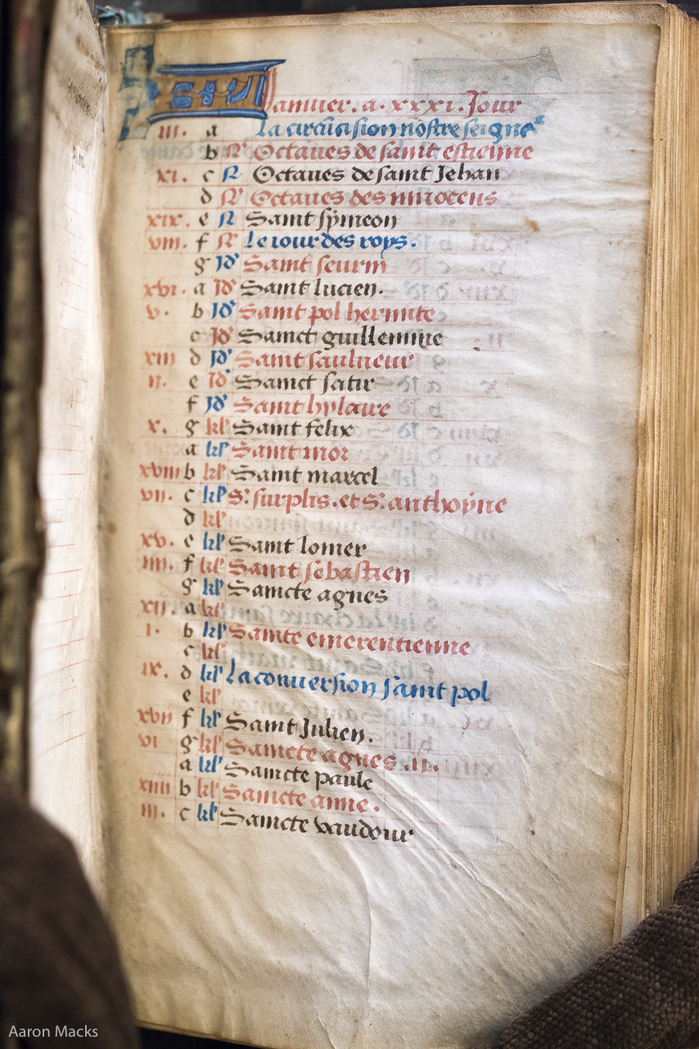Two more manuscripts from the Biblioteca Nacional de Espana, both Parisian, have been added in recent days.
Vitr/24/1 was in the collection of King Charles VIII (see 259), and dates to the very end of the 15th century. It has beautiful calendar, complete in French and graded gold, red/blue. Surrounding the labor of the month, on the outer margin, there are short French poems about the month. The entries are quite a mess, however. 43 appear to be on the wrong date with an additional 27 entries unidentified.
(DB Id: 287)
Vitr/24/7 is an earlier book, dating from circa 1400 with an unknown patron. It is named for a 19th century owner, the Duke of Osuna. The calendar is complete, with an unusual grading system, gold and red/black. Like the other Parisian Hours, this one has a calendar filled with errors. 52 entries are on the wrong date with an additional 65 unidentified.
(DB Id: 280)
Another library joins the database with the addition of Ms.1185 from the Bibliothequè de l’Arsenal, located in Paris near the former site of the Bastille. This is a 15th C. Book from Cambrai, now in northern France. The book is in a very high quality bâtarde hand, with multiple flourished (nearly cadel) capitals in the calendar test. There are also illusionistic borders, with shell-gold backgrounds, on the outer edge of every page, both text and calendar, except for those with more complex decorative programs.
The text of the calendar is in French with some very specific-to-Cambrai entries, such as Bishop Gaugericus (feast in red on August 11 (370), Octave on August 18 (4007), elevation on September 24 (3803)).
An interesting variant is the indication of the Epiphany (January 6 (1488)) (see f.1r below). In French calendars this is usually spelled as La Tiphaine (or a varient thereof), however in MS.1185 it is spelled in hybrid La epyphanie n[ost]re s[iegneu]r. The article is never seen in Latin calendars, but neither Epyphanie nor vocal variants, are seen in French Calendars. The closest match to this entry, oddly, is the early 16th C. Ventian calendar in Houghton MS Typ.1000
(DB Id: 265)
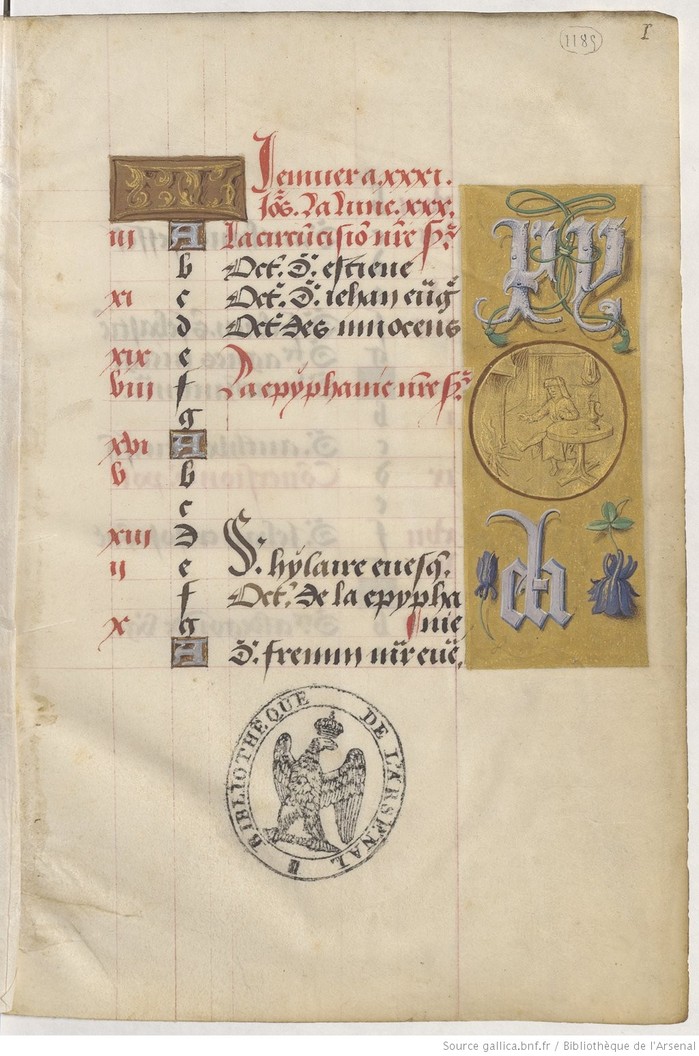
Utopia Cod.111 is one of the many Parisian Hours, but with an unusual pedigree. King Charles VIII was a voracious bibliophile, and so was often gifted manuscripts by those wishing to curry favor. One of these is Cod.111, given by the parisian bookseller Anthoine Vérard about 1488, is an exquisite manuscript and the eponymous work of it’s illuminator, the Master of Charles VIII. It it completely illuminated, with every page having, at minimum, a vegetal border with Old Testament scenes inset in the outer margin. Throughout are full page miniatures. Many are the usual Life of Mary sequence, but some are more inventive, such as an opening depicting the Genealogy of Christ, from Adam through the Jesse on 14v and Jesse through Mary to Christ on 15r.
The calendar is equally lavish in decoration, with 2-columns of feasts set within a architectural border populated with the sign of the zodiac, the labor of the month and various Saints. The scribal work was not well coordinated with the illumanation, with multiple instances of the capitol “s” in a column where the feast is not for a Saint. This lack of communication continues in the month names, each of which is missing the first letter.
The entries are in the common Parisian color scheme, red/blue for common and gold for high-importance feasts. The entries are almost all identifiable, but riddled with errors, usually coming in blocks. For example for the thirteen entries in November 7-19, ten are on the wrong date. Interestingly in that block, the Feast of St Martin of Tours 2872 is on the wrong date but the Octave 2971 is correct. It seems like this block was shifted around to permit two saints with the same date to be included, but in an overly complex scheme (see f.7r below)
(Db ID: 259)
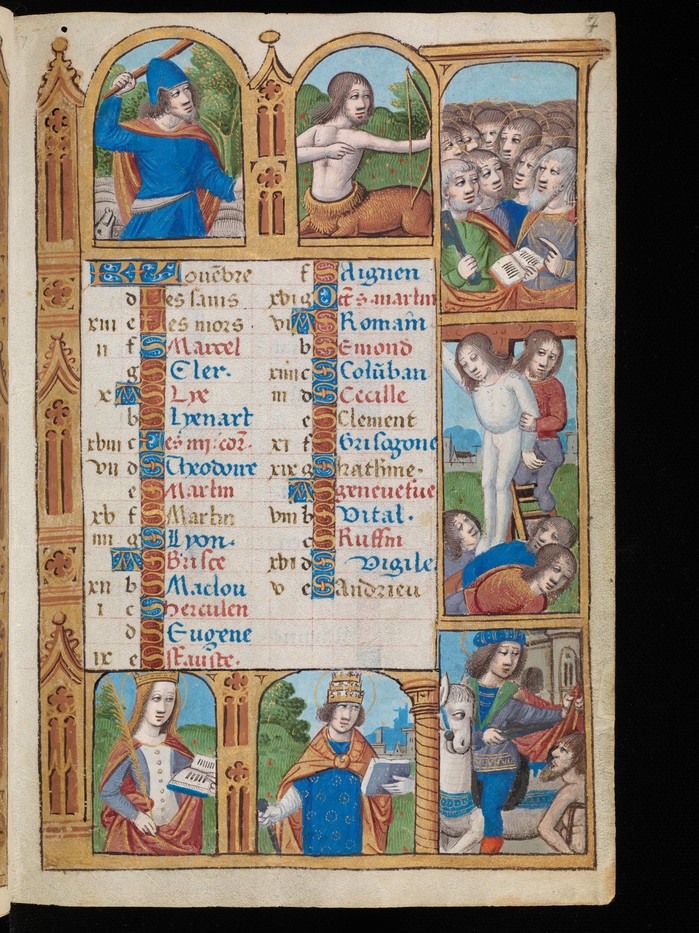
From a new source, the Archives of the Canton of Vaud, comes a nice Parisian Book of Hours, shelfmark P. Château de La Sarraz H 50. As a Swiss Cantonal library, this manuscript is comprehensively catalogued and digitized in e-Codices. Helpfully for localization and dating, this has a colophon* on f. 193v stating that it was made in the workshop of the Parisian bookseller Jacquet Lescuier in 1421 and bought, though possibly not comissioned, by Jean II de Gingins.
The calendar is not terribly unusual for a Parisian complete calendar, with just red and black entries. There are some errors, but no more than expected with a complete calendar. A couple of the entries are unclear due to the gothic biting.
(DB Id: 237)
* Ces heures sont a Jehan de gingins seigneur duione et capitaine surgens darmes pour le roy nostre sire. Et furent faites a larue neufue n[ost]re dame par iaquet lescuier. Lan .mil.CCCC.XXI.
Bibliothèque nationale de France Nouvelle acquisition latine 3093 is one of the multiple fragments of a complex manuscript, which was owned and possibly comissioned by Jean, Duc de Berry (yes, that Duc de Berry). The BnF fragment, called the Très Belles Heures de Notre-Dame, is mostly Book of Hours content, but the manuscript originally contained a Psalter and some of a Missel as well. Even without touching on the complex history of creation and illumination, the calendar is interesting in it's own right. The entries are mostly standard for Paris, though there are a large number of local bishops specified with their See, (see Sts. Savian and Potencian, October 19, on f.Vv below. Their see of Sens is recorded). There are also some of the specifically Parisian royal feasts, including both the Crown of Thorns (Aug. 11) and Relics of St. Chapelle (Sept. 30) and multiple kings and queens.
The coloring seems to have no pattern at all, sadly. There are 4 colors used, red, blue, pink (distinct from the red, perhaps a faded purple) and black, which might be lost gold, and many of the feasts have size indications in the right margin (3 or 9 lessons, or Annuale), but there seems to be no correlation between color and rank. High-rank feasts are often blue, but in November, where the month is mostly full, it seems to be a simple pattern (blue is roughly every 3rd feast), and St. Andrew, an apostle, is pink.
(DB Id: 197)
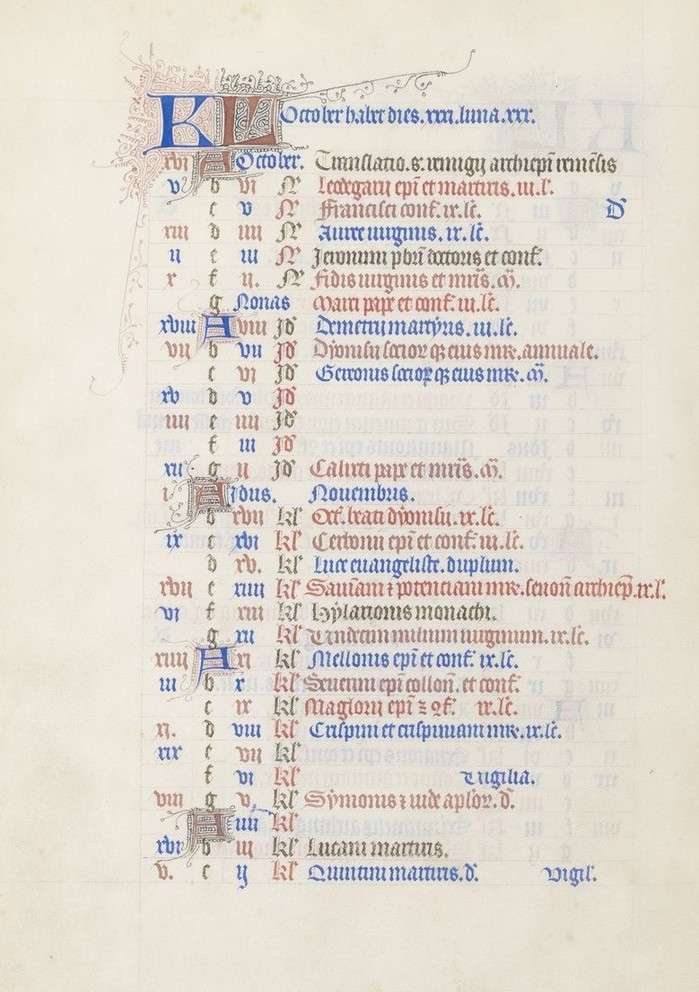
Morgan Library M.92 is another Book of Hours from my recent trip. This one is a very early, 2nd quarter of the 13th century, French book, probably made in Paris but use of Soisson. The first couple of leaves are full-page miniatures of the life of Mary, though only as it pertains to Jesus. They start with the Annunciation and proceed through the scenes of Jesus' first year and then Crucifixion. The last few are the death and accumption of Mary, and these are followed by the calendar, starting on f.15r. This calendar is quite lovely, with rondels for both the labor and the zodiac on the outer margin, and bright gold for the parts of the Roman month (Kalends, Nones, etc)
The calendar is interesting from a scribal-practice sense, as the Lombard capitols, in red and blue, that go with most of the Saints were clearly done by a second scribe. These are wrong quite often, and in ways that are so nonsensical, which is entirely different from the very careful and accurate main scribe. Not all the errors are even on unusual saints, December 25th is "Sativitas d[omi]ni n[ost]ri ih[es]u [christi] in bethle[hem]e" (see f.20v below. The tiny picture is the only one available from the Morgan). The formation of the text in unusual, many more feasts are marked "passio" than one usually finds
(DB ID: 73)
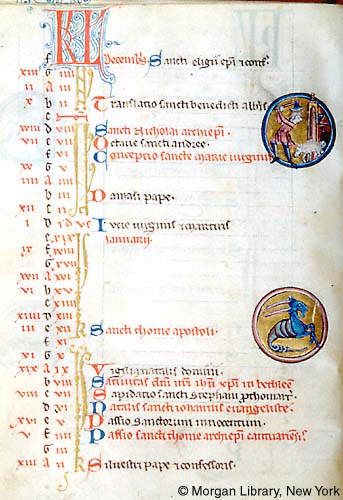
Richardson 10, from Harvard's Houghton Library, is a profoundly weird French Book of Hours, circa 1515. The calendar is Parisian-ish, nearly full, with mostly the standard Paris saints, but not a full Paris-set, i.e. January starts with the Circumcision and lacks St. Geneieve (see f.1r below). After the calendar the book contains the Lords Prayer (in French) and 7 sets of Hours, possibly as one for each day of the week. These Hours include both the usual ones -- Hours of the BVM, Hours of the Holy Cross, the unusual ones -- Hours of Passion. Then it has some completely made-up things -- the Hours of All Saints, the Hours of St. Barbara, a Mass against Pestelence, etc. There are no Gospel pericopes and no obvious Litanies, though there are prayers to St. Catherine and St. Martin of Tours. To round it out, the cover is about 50 years later than the text, brass (or bronze perhaps), with a layer of red paint carved back to reveal the arms and emblem of Catherine de Medici.
(DB ID: 189)
